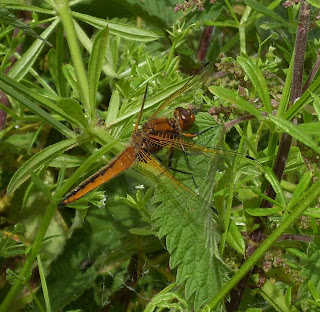Due to the prolonged period of rain in the past week, all the marshland area, and muddy edges of the lakes were entirely flooded. Consequently there were very few wading birds, whilst many of the breeders appeared also to have been washed out. Infact the only birds that appeared to be having any success were the
Common Terns, nesting on the specially built Tern rafts, unaffected by the change in water level. A few birds were however of note, including at least
3 singing Cetti's Warblers,
3+ Hobbies, and at least
6 Garden Warblers (two of which I glimpsed fly into the a hedgerow before vanishing). Dragonflies and Damselflies, however were our savior and provided the majority of our entertainment for the day. Bob and Ken, the experts pointed out
Scarce Chaser to me as well as
Banded Demoiselles and
Blue-tailed Damselfly. The highlight for me was separating the more numerous
Common Blue Damselflies from the
Variable Damselfly. Bob patiently explained how to separate the two by the second segment on the abdomen which appears like a golf ball on a tee for Common and like a wine glass on the Variable! Another speciality were
Small Red-eyed Damselflies, a species that was only first recorded in Britain in 2000 and has subsequently spread to further inland sites. Other species on show included
Black-tailed Chaser,
Hairy Hawker (self found) and
Blue-tailed Damselfly.
Blue-tailed Damselflies mating
Variable Damselfly
segment 2 of Variable Damselfly, showing wine-cup shaped black marking
Blue-tailed Damselfly
Scarce Chaser
Hairy Chaser
Small-eyed Damselfly
I had also heard that the site was particularly good for rarer flowering plants, so decided to take some quick pics of the species I came across, here is a selection, I've only bothered to ID one so far, if anyone can recognise the rest I would be grateful for any comment.
Columbine
overlooking the main marsh


















No comments:
Post a Comment